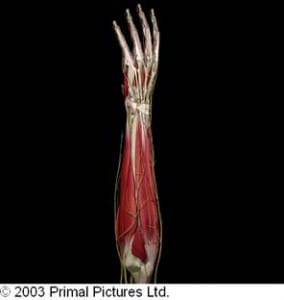TENNIS ELBOW/LATERAL EPICONDYLITIS
The medical name for tennis elbow is lateral epicondylitis, as this condition occurs where the tendons of the forearm insert onto the lateral epicondyle of the elbow joint.

The lateral epicondyle is the site at which the muscles which bend the wrist and fingers backwards originate. There are many muscles which perform this function and similarly originate from this bony process, including the extensor carpi radialis brevis, extensor carpi ulnaris, extensor digitorum and extensor digiti minimi.
Similar to a rotator cuff tendinopathy, lateral epicondylitis is also termed a tendinopathy which particularly affects the extensor carpi radialis brevis, usually secondary to overuse, such as repetitive keyboard use, etc.
The term tennis elbow was coined for this condition as symptoms can occur after an improper backhand and hitting technique, whereby the tennis player attempts to increase power by increasing forearm force rather than relying on core strength, rotator cuff and scapular power.
The causes of tendinopathies are not fully understood, although it has been linked to overuse, trauma, the aging process, gender, weight/waist girth measurement and cardiovascular and metabolic factors.
Common symptoms described for this condition include elbow pain and possibly localised swelling close to the lateral epichondyle of the elbow, which comes on with no real inciting trauma. The pain may refer further down the forearm and tends to get aggravated by repetitive wrist use, such as using a screw driver.
TREATMENT OF TENNIS ELBOW/LATERAL EPICONDYLITIS
At Bodymotion, our treatment approach is based on initially reducing the tension on the common extensor tendon through soft tissue work, ultrasound and stretching of the muscles which act to extend the wrist and fingers. Rehabilitation exercises will also be prescribed to strengthen the common extensor tendon and promote the synthesis of Type 1 collagen. Postural exercises are also beneficial, as is treatment directed at improving the mechanics of the upper limb, neck and mid back.
Evidence to support this approach to patient care can be found below:
- Bisset L, Paungmaili A. Vicenzino B, Beller E. A systematic review and meta-analysis of clinical trials on physical interventions for latearal epicondylalgia. Br J Sports Med 2005; 39:411-422.
- Bussieres AE, Peterson C. Taylor JA. Diagnostic imagine guideline for musculoskeletal complaints in adults – an evidence based approach – part 2: upper extremity disorders. J Manipulative Physiol Ther 2008 Jan;31(1):2-32.
Although inflammation may play a role in the initial pathogenesis of a tendinopathy, recent tendon research has uncovered that there is little or no evidence of inflammatory changes in the vast majority of tendon complaints and may explain why anti-inflammatory measures such as NSAIDS (nurofen/ibuprofen) and ice have little effect in relieving symptoms. A supportive elbow strap may, however, help to reduce the tension on the muscle tendon complex of the common extensor tendon and help alleviate some of the symptoms arising from this condition.
One of the key elements in treating Tennis elbow is deciphering what activities have taken place to initiate symptoms in the first place. From here corrective training or ergonomic advice is paramount to prevent recurrences of future episodes of elbow pain
(The list of conditions given above and subsequent explanations are intended as a general guide and should not be considered a replacement for a full medical examination. Should you wish to discuss any of these conditions with our chiropractors, please do not hesitate to phone the clinic on 020 7374 2272 or email enquiries@body-motion.co.uk).
Our team of chiropractors and massage therapists are on hand to answer any questions you may have, so get in touch today via enquiries@body-motion.co.uk or on +44 (0)20 7374 2272.
